(转)vmware下给linux虚拟机扩容
“Well, here’s another fine mess you’ve gotten me into”
Let us pretend that you have an Ubuntu Server which has been running for several years and it has been doing it’s assigned task(s) nicely, until one day you make a change to your methodology/assumptions/workflow/tasks therefore the allocated Virtual Hard Drive (VHD) size is no longer sufficient. There are many reasons for this, but I ran into this issue twice in one weekended because I enabled a JDS as a Distribution Point (thus MySQL was eating needing a lot of space) and wanting to test multiple NetBoot NBI sources (because 10.10.2 seems to be causing imaging troubles). I need to increase the size of two different VHDs, however if you setup your Ubuntu Server via “Easy Install Mode” enlarging the VHD is not that strait forward.
Doing a quick search to see what VMware has to say about this issue returns less than helpful information for Ubuntu Servers by stating man fdisk. Google searching throws a lot of ideas, therefore I’m providing what I’ve learned from a couple of hours of research.
Increase size? I don’t think that word means what you think it means
First lets get a baseline of a default “Easy Install” of Ubuntu Server. We can see that we have a 20GB VHD by several ways:
- Looking at our VMware Fusion Setup
- Running
sudo fdisk -l - Running
df -H
Here is my test VM as it stands right now. You can see the VHD settings are for 20GB (really 21.5, guessing there is a rounding error somewhere), and that our primary partition is /dev/sda1 with 19GB drive.
sadmin@ubuntu:~$ sudo fdisk -l
Disk /dev/sda: 21.5 GB, 21474836480 bytes
255 heads, 63 sectors/track, 2610 cylinders, total 41943040 sectors
Units = sectors of 1 * 512 = 512 bytes
Sector size (logical/physical): 512 bytes / 512 bytes
I/O size (minimum/optimal): 512 bytes / 512 bytes
Disk identifier: 0x0001bae9
Device Boot Start End Blocks Id System
/dev/sda1 * 2048 37750783 18874368 83 Linux
/dev/sda2 37752830 41940991 2094081 5 Extended
/dev/sda5 37752832 41940991 2094080 82 Linux swap / Solaris
sadmin@ubuntu:~$ df -H | grep sda
/dev/sda1 19G 1.4G 17G 8% /Now it would be really nice if VMware Fusion’s tools to increase the VHD worked as expected. If we could just simply move our slider (or type in a new value) for our desired HD space that would actually increase our storage space, that would be perfect!
 Result VMware Fusion VHD setting after adjusting from 20GB to 30GB.
Result VMware Fusion VHD setting after adjusting from 20GB to 30GB.
We start our Ubuntu Server to verify that our new drive is now 30GB of storage, however what we see is the Virtual Environment believes we have 30GB (32.2 specifically) but our /dev/sda1 partition is still at 19GBs?!
sadmin@ubuntu:~$ sudo fdisk -l
Disk /dev/sda: 32.2 GB, 32212254720 bytes
255 heads, 63 sectors/track, 3916 cylinders, total 62914560 sectors
Units = sectors of 1 * 512 = 512 bytes
Sector size (logical/physical): 512 bytes / 512 bytes
I/O size (minimum/optimal): 512 bytes / 512 bytes
Disk identifier: 0x0001bae9
Device Boot Start End Blocks Id System
/dev/sda1 * 2048 37750783 18874368 83 Linux
/dev/sda2 37752830 41940991 2094081 5 Extended
/dev/sda5 37752832 41940991 2094080 82 Linux swap / Solaris
sadmin@ubuntu:~$ df -H | grep sda
/dev/sda1 19G 1.4G 17G 8% /What we have done is expanded the allowable space to be used, but we didn’t actually adjust the partition size. We need to do that with some more awesome open source tools.
Steps to Increase your VMware Fusion partition
First we are going to use a Linux Live CD called GParted. Download their 234MB ISO to your VMware Fusion host so you can attached the ISO to the CD/DVD drive. Once attached, use the Startup Disk options in VMware Fusion to select the CD/DVD drive.

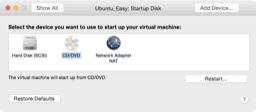 GParted attached as a CD/DVD drive, then booting from that drive.
GParted attached as a CD/DVD drive, then booting from that drive.
Assuming you are a native English speaking individual and that you have a “US” keyboard setup, you can safely hit the Enter key for a couple of times to get to the GParted application. GParted will show you some critical information that we must overcome:
- Our original partition of 20GB is at the beginning
- Our swap space is in the middle
- Our extra space is at the end
Unfortunately with this GUI application you cannot just “drag” or “move” the extra space next to our original drive to expand your partition. Instead, we have to methodically move things around so everything lines up in the proper order. To do this we’ll perform the following steps in order:
- Enlarge the “extended” space to take over our unallocated area
- Move our swap space from the beginning to the end of our “extended” space
- Truncate the “extended” space to only focus on the swap space
- Enlarge our primary partition to use the new unallocated area
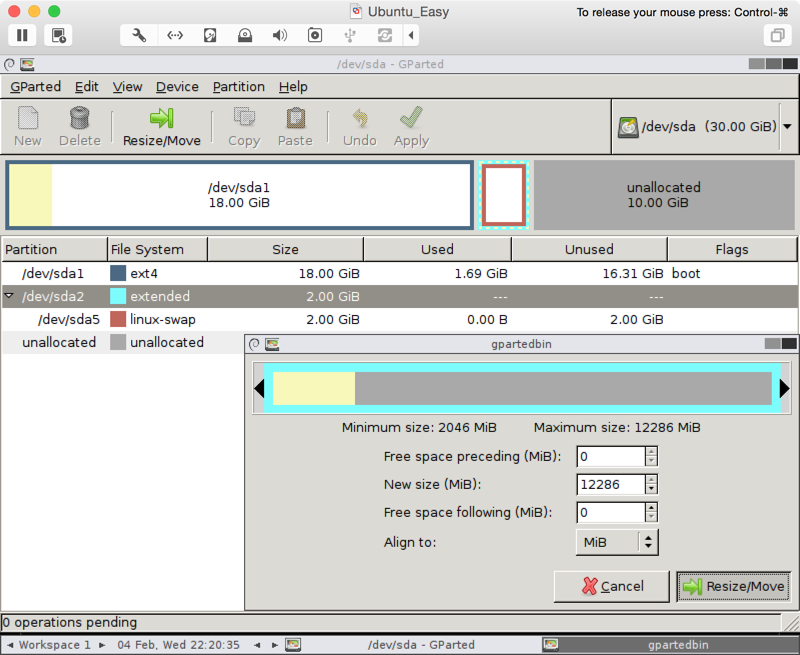 Select the /dev/sda2 "extended" and Resize/Move to take over the unallocated area, and hit apply.
Select the /dev/sda2 "extended" and Resize/Move to take over the unallocated area, and hit apply.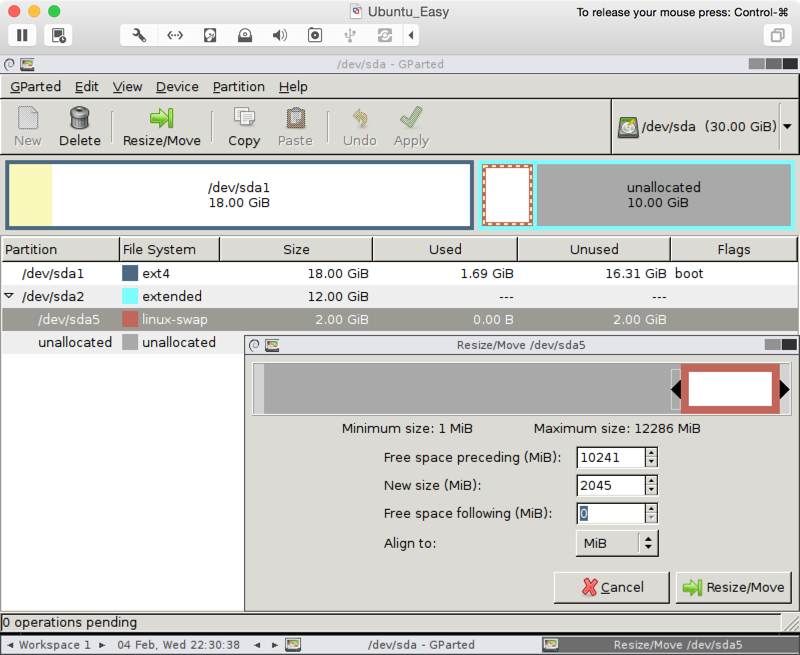 Select the /dev/sda5 "linux-swap" and Resize/Move to the end of our extended area, and hit apply.
Select the /dev/sda5 "linux-swap" and Resize/Move to the end of our extended area, and hit apply.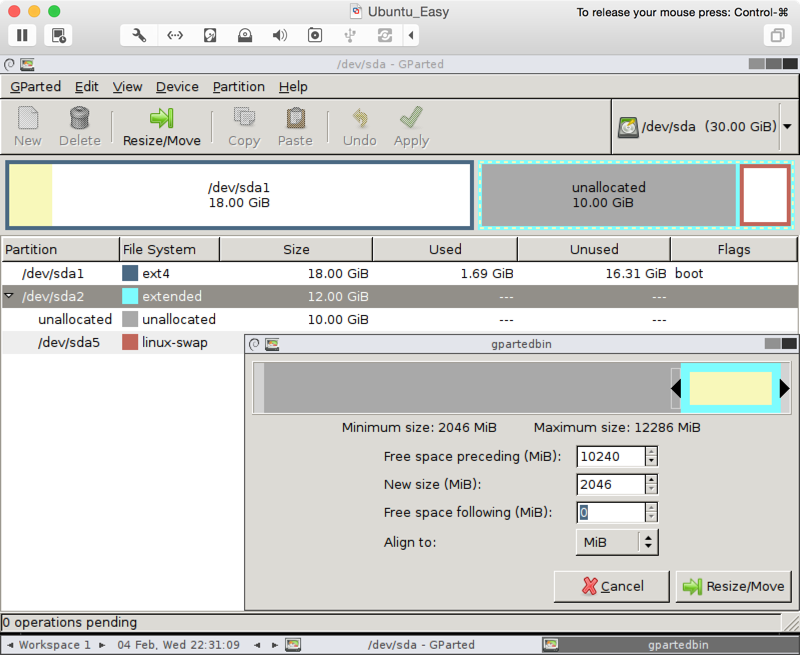 Select the /dev/sda2 "extended" to create new unallocated space preceding the "linux-swap" space.
Select the /dev/sda2 "extended" to create new unallocated space preceding the "linux-swap" space.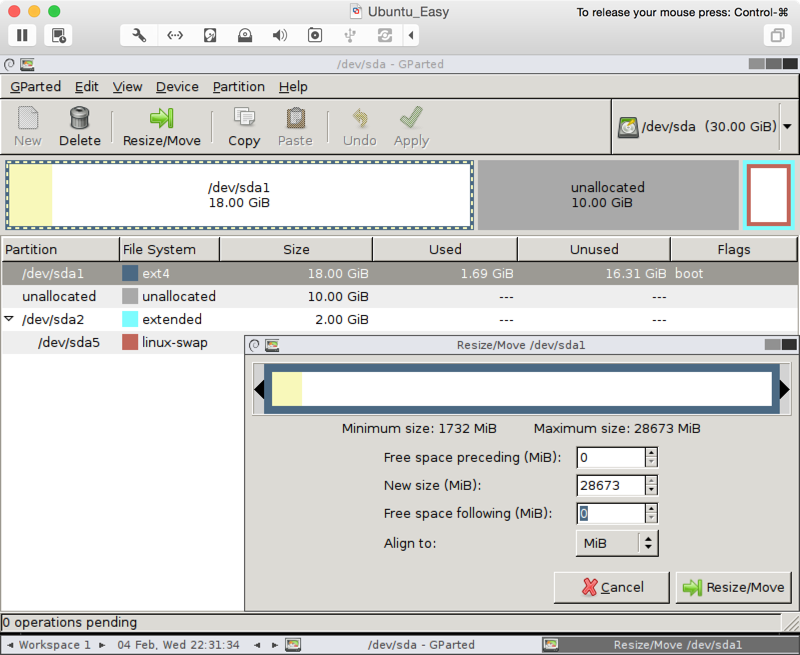 Select the /dev/sda1 and Resize/Move to take over our new unallocated area.
Select the /dev/sda1 and Resize/Move to take over our new unallocated area.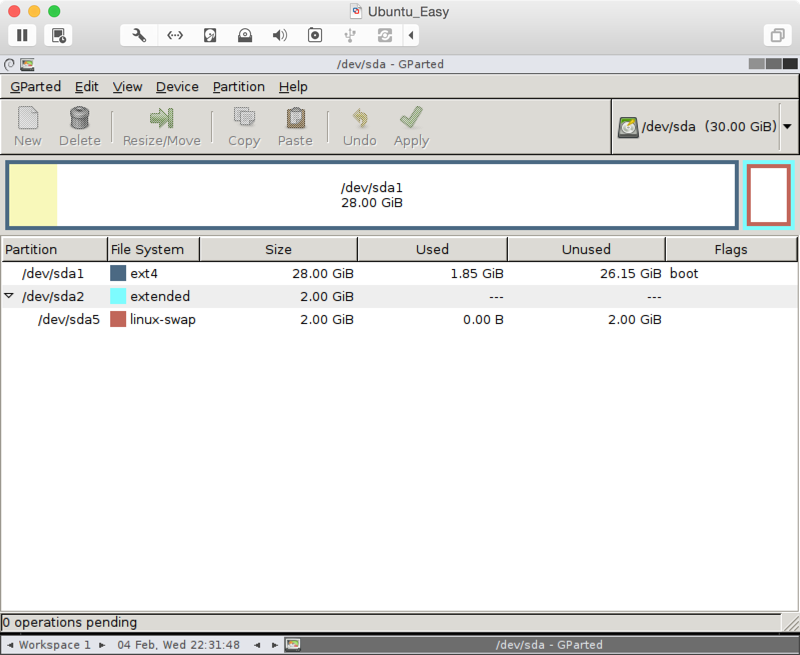 Verify our primary partition now has the 30GB storage (minus 2GB for swap in this example).
Verify our primary partition now has the 30GB storage (minus 2GB for swap in this example).
To verify everything is running again, change your startup disk back to your Hard Drive in VMware Fusion, restart your VM and run the same commands from the beginning.
sadmin@ubuntu:~$ sudo fdisk -l
Disk /dev/sda: 32.2 GB, 32212254720 bytes
255 heads, 63 sectors/track, 3916 cylinders, total 62914560 sectors
Units = sectors of 1 * 512 = 512 bytes
Sector size (logical/physical): 512 bytes / 512 bytes
I/O size (minimum/optimal): 512 bytes / 512 bytes
Disk identifier: 0x000752bd
Device Boot Start End Blocks Id System
/dev/sda1 * 2048 58724351 29361152 83 Linux
/dev/sda2 58724352 62914559 2095104 5 Extended
/dev/sda5 58726400 62914559 2094080 82 Linux swap / Solaris
sadmin@ubuntu:~$ df -H | grep sda
/dev/sda1 30G 1.4G 27G 5% /reference:
https://www.justinrummel.com/resizing-a-vmware-fusion-ubuntu-server-virtual-hard-drive-via-easy-mode/
(转)vmware下给linux虚拟机扩容的更多相关文章
- VMware下安装linux虚拟机
安装VMware [下一步] [下一步] 点击[自定义],[下一步] 更改安装目录,[下一步] [下一步] [下一步] [跳过] [完成] 点击桌面图标 如下勾选,输入邮箱,[继续] [完成] 安装l ...
- Vmware 下安装linux虚拟机
由于想自己玩玩linux系统,就想着装一个linux的虚拟机,虚拟机vmware很好找,也很好用,但是linux镜像安装老是出问题,然后就找了很多版本的,最后实验成功一种,在这里分享给大家. 一.安装 ...
- 给VMware下的Linux扩容磁盘空间到根分区(以centos7.0为例)
一.扩展VMWare硬盘空间 关闭Vmware 的 Linux系统,这样,才能在VMWare菜单中设置: VM -> Settings... -> Hardware -> Hard ...
- VMware下安装Linux系统,ORACLE软件,DBCA建库
操作系统安装 在vmware下安装Linux (OEL5.6),用于数据库服务器 1.打开vmware,选择"创建新的虚拟机" 2.选择自定义安装 3.选择虚拟 ...
- VMware ESXi CentOS Linux虚拟机安装VMware Tools教
转自VMware ESXi CentOS Linux虚拟机安装VMware Tools教程 | 一米居 http://www.yimiju.com/articles/548.html 最近一周在学习和 ...
- VMware下的Linux系统中Windows的共享目录,不支持创建软连接
[问题] 在编译VMware下的Linux系统对从Windows中共享过来的文件,进行编译的时候,遇到: ln: creating symbolic link XXXXXX : Operation ...
- VMware下安装Linux(Centos)步骤
VMware下安装Linux(Centos)步骤 准备步骤:(安装软件教程采用 VMware 9 .Centos6.5 为例) 启动VMware的画面 点击File--->New Virtua ...
- win7下安装 LINUX虚拟机
文件名: VMware-workstation-full-10.0.6-2700073.exe 百度云共享链接: pan.baidu.com/s/1o6McGmI VMware workstation ...
- Vmware下的Linux系统,安装WPS报错:[Errno 256] No more mirrors to try
最近新装了虚拟环境Vmware下的Linux系统,准备看doc文档发现不能读取,才想起来一起都是重新开始的~没别的~开始安装吧: 1.关虚拟机Linux,添加cdrom镜像ISO文件--开虚拟机--- ...
随机推荐
- solidity-library
library 1)直接使用使用库合约的合约,可以将库合约视为隐式的父合约(base contracts),当然它们不会显式的出现在继承关系中.意思就是不用写is来继承,直接可以在合约中使用: lib ...
- Java相关框架资料及其基础资料、进阶资料、测试资料之分享
个人说明:只为分享,不为其他,愿所有的程序员们在编程的世界自由翱翔吧! 在我看来,只有不断实战,不断学习,不断积累,不断归纳总结,形成自己的核心竞争力,方能在未来竞争中脱颖而出! 程序员谨记!重要的事 ...
- PAT A1153 Decode Registration Card of PAT (25 分)——多种情况排序
A registration card number of PAT consists of 4 parts: the 1st letter represents the test level, nam ...
- Yarn 入门
Yarn 是快速.可靠.安全的 js 包管理器. 关键词: nodejs, 包管理, yarn 简介 Yarn 是快速.可靠.安全的 js 包管理器. 快速 - Yarn 会缓存它下载的每个包,所以无 ...
- 各种工业以太网比较(EtherCAT,EtherNet/IP,ProfiNet,Modbus-TCP,Powerlink)
EtherCAT(以太网控制自动化技术)是一个以以太网为基础的开放架构的现场总线系统,EterCAT名称中的CAT为ControlAutomation Technology(控制自动化技术)首字母的缩 ...
- C# 实现表单的自动化测试<通过程序控制一个网页>
学历代表你的过去,能力代表你的现在,学习代表你的将来 十年河东,十年河西,莫欺少年穷 学无止境,精益求精 C# 实现表单的自动化测试,这标题看着就来劲!那么,如何通过C#程序控制一个网页呢? 在此,以 ...
- Task 异步编程测试案例及基础应用说明
对于多线程,我们经常使用的是Thread.在我们了解Task之前,如果我们要使用多核的功能可能就会自己来开线程,然而这种线程模型在.net 4.0之后被一种称为基于“任务的编程模型”所冲击,因为tas ...
- [Spark][Python]DataFrame select 操作例子II
[Spark][Python]DataFrame中取出有限个记录的 继续 In [4]: peopleDF.select("age","name") In ...
- CRC---循环冗余校验
typedef unsigned char uchar; typedef unsigned int uint; typedef unsigned short uInt16; uint crc; // ...
- 微信小程序:java后台获取openId
一.功能描述 openId是某个微信账户对应某个小程序或者公众号的唯一标识,但openId必须经过后台解密才能获取(之前实现过前台解密,可是由于微信小程序的种种限制,前台解密无法在小程序发布后使用) ...
